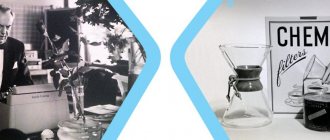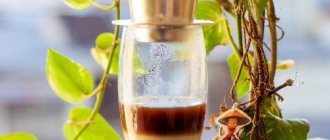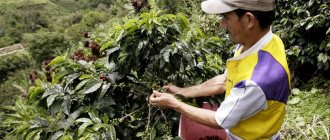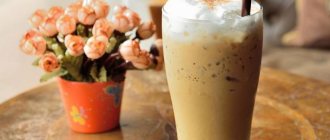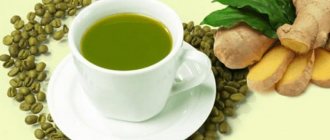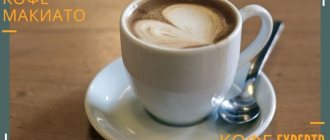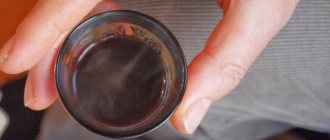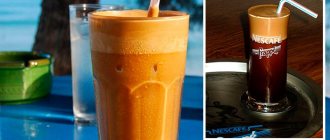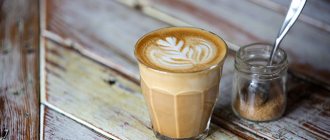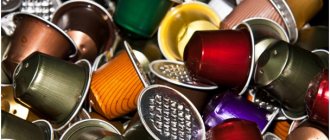How do you brew your usual coffee? Maybe you use a cezve, a carob coffee maker or a Kemesk?..
Have you heard about the special coffee fin
for traditional brewing of Vietnamese coffee? Make yourself comfortable, now we will tell you about a traditional Vietnamese coffee maker or, as it is also called, a coffee fin for brewing traditional Vietnamese coffee.
About a couple of centuries ago, one very well-known tradition of brewing coffee developed in Vietnam - using a coffee filter press. This method of brewing is so beloved by the Vietnamese that it is still used almost everywhere, with the only exceptions being European chain coffee shops in Vietnam.
But what is a Vietnamese filter press, and what is the secret of its popularity in Vietnam?
What is Vietnamese coffee fin?
Vietnamese coffee fin is a special utensil for brewing coffee. Externally, a coffee fin looks a lot like a small cup with a lid, but it is not exactly the cup from which you can drink coffee.
The fact is that the Vietnamese coffee fin has a special perforation - small holes at the very bottom of the bowl, through which ready-made Vietnamese coffee is poured.
It all happens like this: a coffee fin is placed on top of a regular cup or glass, ground Vietnamese coffee is poured into it, poured with water and wait for all the drops of extracted coffee to completely drip into the lower glass. This method of making coffee is traditionally called Vietnamese coffee recipe. This is a kind of special coffee ritual, which in terms of importance for the Vietnamese themselves can even be compared with the importance of tea ceremonies in Chinese folk traditions.
By the way, Vietnamese coffee fin has other names. Fin for coffee can be called: Vietnamese press filter, Vietnamese coffee filter, coffee filter press, coffee filter, coffee filter coffee maker and other similar options.
How to brew your ideal coffee in Finland?
First, let's decide which coffee is best suited for brewing in a Vietnamese coffee maker. It is Vietnamese coffee that reveals itself best in Finland. Here you can buy Vietnamese coffee, which is suitable for filter brewing. Coffee should be medium grind
,
dark roast is enough.
─ It is better to use transparent containers for brewing. Place a cup of fin on your cup/glass. You can first pour boiling water over the fin, but this is not necessary.
─ Add coffee. Please look at what the grind should be - not to dust, as for Turks, but not coarse either. The texture should be like medium-ground sea salt. If you grind the coffee incorrectly, in the first case it will leak through the holes in the filter, in the second case the water will spill and will not be able to extract the coffee.
How much to sprinkle? To the line. If you pour too much, the coffee will take a long time to brew and will turn out very rich; if it is too low, it may turn out watery. Usually the level is achieved through experience. I add 2-3 teaspoons, depending on the type of coffee (Arabica more, Robusta less). Shake a little to set the coffee.
─ Close with a tamper. We compact the coffee for better extraction.
─ Sprinkle a small amount of water to wet the coffee. The water temperature should be 90-96 degrees. That is, a minute after boiling. You can spill it a couple of times. Important!
Pour water directly into the center, where the highest part of the handle is, then your tamper will not move anywhere and will not rise.
─ Slowly, directly to the center, pour in the rest of the water. Cover with a lid and wait for about 4-7 minutes.
─ You can enjoy it!
If you want to make a traditional Vietnamese drink with ice, read this detailed article
There are some points that beginners need to know.
─ Be sure to pour condensed milk BEFORE brewing. ─ If you need it, add ice to the cup BEFORE brewing (if you add ice after, your coffee will be diluted with water and have a dubious taste). It is advisable, if you want to make iced coffee, to add a little more coffee when brewing. ─ Coffee should drip 1-2 drops at a time. That is approximately 50-70 drops per minute. If it drips faster for you, you did something wrong. But this is not scary, the perfect coffee is achieved after about 3-4 attempts ─ You need to understand that the same coffee brewed using different methods will manifest itself differently.
─ If you need it, add ice to the cup BEFORE brewing (if you add ice after, your coffee will be diluted with water and have a dubious taste). It is advisable, if you want to make iced coffee, to add a little more coffee when brewing. ─ Coffee should drip 1-2 drops at a time. That is approximately 50-70 drops per minute. If it drips faster for you, you did something wrong. But this is not scary, the perfect coffee is achieved after about 3-4 attempts ─ You need to understand that the same coffee brewed using different methods will manifest itself differently.
At the same time, European types of coffee may not be suitable for Fin, due to the fact that during brewing they will completely lose their taste and aroma.
Why do the Vietnamese use fin to brew coffee?
The culture of drinking coffee, as we remember, was imposed on the Vietnamese by the French, and they also began to export all Vietnamese coffee. They even came up with their own roasting – French. This French roast involved very heavily roasted coffee beans. The coffee became very dark and, according to the French, such a strong roast should have given the coffee chocolate notes.
Yes, the heavily roasted Arabica beans did impart chocolate notes to the coffee. But the fact is that then, in the 19th century, the Vietnamese were just trying to curb the aromatic and tasty Arabica. Arabica is a very capricious tree, which is often susceptible to various diseases, so there was little Arabica in Vietnam in the 19th century. But there was more than enough picky, strong robusta. Therefore, they exported mainly heavily roasted Vietnamese robusta.
As we know, Robusta has 2 very strong sides - high caffeine content and bitterness. To reduce the level of bitterness in robusta coffee, the Vietnamese themselves came up with the idea of roasting coffee beans in coconut oil. This method worked with a bang: Vietnamese coffee turned out rich, dark, invigorating, dense and with a completely original taste. But cooking heavily roasted and oiled Vietnamese coffee, say, in the same cezve (Turk), returns to the coffee the very bitterness that the Vietnamese tried so hard to get rid of. And according to one of the most common opinions, only the coffee filter, due to its structural features and coffee preparation methods, did not impart unwanted bitterness to Vietnamese coffee beans.
Coffee philosophy in Vietnam
Absorbing coffee brewed in Fin is not the act of drinking as such, not at all! This is meditation in at least two stages. And there is a corresponding philosophy too.
The first stage is observing the process of brewing coffee, or rather, its passage through the fin. The greatest thrill is when the first drop of coffee from the fin falls onto a pristine layer of condensed milk. But you very rarely catch this moment: the waiters enjoy it while they bring coffee to your table.
The second stage is the actual coffee drinking. Waiting for the ice to thaw... Stirring... Drinking one sip of coffee and then a few sips of green tea... Chatting between sips or just observing the surroundings: coffee shops here, thanks to the climate, can afford vast outdoor terraces... And let the whole world wait!
Table in your favorite cafe Thuần Việt
In general, drinking coffee in Vietnam is not to drink and drive to work, not to simply excite the nervous system and not doze off at the workplace. No! People here drink coffee while leafing through a newspaper, watching the news on their phone (many coffee shops have free Wi-Fi) or chatting with friends, both in the morning, during the day, and in the evening. They drink coffee in expensive coffee shops, sparkling with Apple netbooks. They drink coffee in cheap places, which Russians call “under the fence, on chairs.”
Cafe “under the fence, on chairs”
The latter option will most likely not be coffee (long live the Vietnamese chemical industry). But the world will wait anyway... Peace awaits in the morning in Hoi An, and in Dalat, and, we suspect, in other cities of Vietnam.
Benefits of brewing Vietnamese coffee in a coffee fin
• Vietnamese coffee fin is one of the most budget-friendly options for brewing Vietnamese coffee quickly and tasty.
• Vietnamese coffee fin is relatively small in size. It is compact and easy to use, especially when traveling or outdoors.
• Vietnamese coffee fin has no expiration date. If the coffee fin is made of steel, then it will definitely last for many, many years.
• Vietnamese coffee fin does not require close supervision throughout the entire process of preparing Vietnamese coffee.
• It is easy to add or, conversely, subtract the required amount of ground coffee and water from Vietnamese coffee fin.
• It’s a pleasure to experiment with Vietnamese coffee fin and create your own Vietnamese coffee recipes anywhere and at any time.
Vietnamese traditions
We talk about the magnificent taste of coffee from the mountainous province of Dalat, pay tribute to the quality of Vietnamese Robusta, and the ability of professionals to create interesting blends. But the people of Vietnam mainly export their coffee treasures, cultivated with skill and love. They have their own approach to coffee drinking and their own preferences.
The Vietnamese do not hesitate to add roasted grains or soybeans to robusta, brew this mix in their favorite wine and, invigorated, go to work. Probably, having survived a difficult war, they learned to appreciate the simple joys of life, and they provide the opportunity to “gourmet” to other nations and tourists coming to the country.
Still, the Vietnamese have unique recipes that are worth learning about. And under their guidance, prepare your own original coffee dessert.
White Vietnamese coffee with condensed milk
We brew coffee in Finland using the already familiar method. For one serving you will need:
- 1.5 – 2 teaspoons of ground coffee, Arabica or Arabica plus 20% Robusta;
- 150 ml boiling water;
- 2-3 teaspoons of condensed milk.
Pour condensed milk into the cup on which the saucer is placed. Coffee drips onto it from above, the border of the contrasting colors of the combined products remains clear.
Please note: the Vietnamese will not choose high-quality condensed milk, as you and I will certainly do. For them, “milk” with palm oil, which is included in the ranks of products harmful to health, is quite suitable. For people, the process itself and a good mood are more important. Maybe they drink lower quality drinks, but with a sincere smile of pleasure.
The clarity of the line separated by brown coffee and white condensed milk is disrupted by the invasion of crushed ice. Mix the ingredients and enjoy drinking a pleasant, refreshing drink that is a good tonic on a hot day.
Egg coffee
It is also called Hanoi coffee. The appearance of the drink is associated with the shortage of dairy products that arose in Vietnam in the difficult 70s of the twentieth century. The Vietnamese were looking for a way to smooth out the tart, bitter taste of their favorite robusta and found a good option. Egg yolk did the job of a milk substitute.
Since there is currently no shortage of dairy products in Vietnam, they are present in modern recipes. The desserts turn out amazing; they are called “liquid Tiramisu” for their delicate creamy coffee taste.
What you will need:
- 8 - 10 grams of ground coffee, this is about a heaped tablespoon. Good quality robusta can be used;
- 200 ml filtered water;
- yolk of one egg;
- 1 teaspoon sugar, preferably vanilla;
- 1 tablespoon condensed milk.
Prepare coffee at your own discretion: in a coffee machine, in a Turkish coffee pot or in a Fin. Beat the egg yolk thoroughly in a bowl until a stable foam forms, then carefully add the condensed milk. We spread the elegant fluffy foam on hot coffee poured into a transparent glass. Decorate it with cocoa powder or grated cinnamon on top. If you wish, you can stir all this splendor thoroughly and drink slowly through a straw.
Vietnamese coffee recipe for the whole family or for entertaining friends
The portion turns out to be impressive, so think in advance who will drink it. Rave reviews from tasters and insistent demands to declassify the recipe are guaranteed!
We prepare products:
- Vietnamese ground coffee - 3 heaped tablespoons;
- yolk of one egg;
- condensed milk – 2 teaspoons;
- water – 1.5 l.
Preparation: In a bowl, beat condensed milk, yolk and 1 spoon of coffee until a thick foam forms. We brew coffee using any method from the remaining coffee and water. Pour the finished drink into cups and decorate with egg and coffee mixture.
Secret recipe for a healing drink for adults:
- a tablespoon of ground coffee from Vietnam;
- 100 ml water;
- 100 ml rum (or brandy);
- 2 teaspoons sugar;
- a pinch of ground cinnamon;
- 3 cloves of cloves.
Mix all the ingredients in a large Turk or other suitable container and put on fire. As soon as signs of boiling appear, remove from heat, let it brew for a minute, and pour into prepared glasses. The aroma instantly disperses bad mood and mental blues. What can we say about viruses and pathogens - they disappear, forgetting to say goodbye!
Buy Vietnamese fin and prepare wonderful coffee for yourself and your loved ones. May there be many joys and new tastes in your life. And I’d really like to know how the tasting of Vietnamese coffee delicacies went in your family. Please share!
Vietnamese coffee and health
As mentioned above, coffee for brewing in Finland is often fried in oil (technologically, in most cases, oil is added after roasting, while the coffee is still hot and actively absorbs everything; but, according to rumors, some craftsmen can add oil during frying; in this article we will use the expression “fry coffee in oil,” although often technically this is not entirely true). The reason is banal and topical - it’s cheaper.
- Coffee intended for roasting in oil does not need to be of high quality, because the oil will still add its own “unique” note. Actually, the purpose of the oil in such coffee is to saturate the roasted grain almost to the point of charcoal with at least something. Often, butter is margarine with flavors: this is how you get “vanilla”, “chocolate” coffee, “cappuccino” or even “cherry” coffee.
- Oil-roasted coffee beans are heavier than dry-roasted coffee beans. Therefore, all other things being equal, a kilogram package of “butter” coffee contains fewer beans than the same package of “dry” coffee. This means that there will be more packages of “butter” coffee from the same number of beans as “dry” coffee.
- We don’t undertake to judge the technological process, but in our unprofessional opinion, the process of roasting “butter” coffee is simpler, because requires less attention: there is no need to fix points on the temperature curve (all sorts of Yellow, Approach and so on, which we learned about already in the second winter thanks to Valentin Kruzenshtern), there is no need to select roasting modes for a specific batch of grain with a specific humidity and properties. In short, the technical process in this case is approximately the following: fry the grain until dark brown and then flavor it with margarine. Everything ingenious should be simple.
There is information in Russian-language blogs that Vietnamese people need fin to brew coffee, because the best varieties are exported, and what is left is used for domestic consumption. And fin supposedly improves the taste of this “residual” coffee by removing the bitterness.
In our, again, unprofessional opinion, the bitterness, if it has been preserved after roasting in coffee, cannot be removed with a single fin. At least it didn't work out for us. Perhaps, remove the coffee itself from the fin. And fill in a new one, without bitterness. And there are varieties of excellent quality in the domestic market of Vietnam. Another thing is that their price is significantly higher than average, as probably should be the case with a quality product.
We are closer to the opinion that fin appeared as a cheap and quick means of brewing coffee (any kind, both cheap and not so cheap). It does not require additional heating (as is the case with a Turkish press), and the design is more reliable than, for example, a French press (there are many dented but successfully functioning presses in coffee shops).
Why are we talking so much about fin and oil? And besides, high-quality coffee is expensive. But the average income in Vietnam is still low. But I want coffee; the French brought it back in the 19th century. And people are like that, they adopt each other’s habits. So, in order to give every suffering Vietnamese person a divine drink, manufacturers resort to various tricks of varying degrees of legality. Natural coffee here is successfully made from soy, corn and flavorings. In severe cases, they can also tint with charcoal. Without the proper experience (and what kind of experience can a Russian person, raised on instant Nescafe with Jacobs, have?), you cannot distinguish the taste of such a drink from coffee. Therefore, if you want to drink coffee cheaply, maybe even on “chairs”, together with the Vietnamese, while paying 8 - 12 thousand dong (in Nha Trang), keep in mind that it will not be coffee (8 - 12 thousand). dong at the time of publication are approximately 20 - 30 rubles, and we have an article about exchange rates and bank cards). And if you bought “desevo-desevo” coffee at the market, and you like the taste of it, and you giggle at your fellow vacationers who “overpaid”... Well, blessed is he who believes - he is warm in the world.
Well, it took a long time again! Butter, fin, soy... What does health have to do with it?!
If the oil is used directly in the frying process, then probably more than once. And not two. And not three... In general, we are adults, right? We've read articles about why chips, French fries and buttery pies made on an industrial scale are harmful? It’s the same with buttered coffee: there’s not enough butter, but there’s a lot of coffee. So why change the oil for each new batch? It’s possible after the tenth... And the fact that some carcinogens have formed in the oil... Everything will fall into the ground, everything will be dust... We didn’t come up with this... This is what the classic said.
And if we are talking about a “margarine” with flavorings, which is added after roasting to the still hot grain, who knows what is in that margarine, besides the flavorings? And what processes occur in it when it comes into contact with hot coffee?
Maslitse for cheap “buttery” coffee
The photo was taken while walking through the back streets of Nha Trang with Nikita Starostin
Regarding soy-corn flavored coffee. We have a good friend Anna. She has been living in Vietnam for 5 years, and therefore her group “ELO Nha Trang” contains a lot of information that is very useful to domestic tourists. And Anna knows a doctor of traditional medicine. And the opinion of the wise doctor is this: “Don’t drink coffee on the chairs - you’ll become a little goat...” Oh, no, that’s not true: “You’ll poison your body, then you’ll spend the savings “on the chairs” on doctors, and you’ll also have to pay extra on top.” Because only the manufacturer knows what is mixed in that “coffee.” He knows, but is silent.
Of course, if your trip to Nha Trang is for 2 weeks, then you can drink coffee on the chairs. But we don’t recommend taking a suitcase with very cheap market coffee with you to Russia. No need. Better than 2 suitcases. But from good places.
Vietnamese coffee preparation method
To obtain a balanced taste and magical rich aroma, it is advisable to prepare all ingredients immediately before cooking. It is allowed to use packaged ground coffee, where robusta occupies a leading position in the composition. A popular option, adapted for the mass consumer, is mixing several varieties in proportions with an acceptable ratio of 70/30 or 60/40, where the 1st digit is the percentage of robusta. The rest can be occupied by the softest Arabica and other types. The indigenous people of Vietnam also do not refuse blending. This is how the traditional drink acquires an original taste and aftertaste.
How to read a Vietnamese menu in a coffee shop (dictionary)
Most coffee shops in Nha Trang have menus in at least two languages: Vietnamese and English. There are quite a lot of options when the menu includes both Russian and Chinese. So, most likely, there will be no problems with the order. But if, nevertheless, you find yourself in some small coffee shop where only a Vietnamese menu is available, don’t get lost. Use our mini-dictionary.
cà phê đen - ke fe den - black coffee - black coffee; cà phê sữa - ke fe sya - coffee with milk (usually with condensed milk) - milk coffee; cà phê đá - de (yes) - with ice - cold coffee or coffee with ice; cà phê nóng - naun (nan) - hot - hot coffee; nguyên chất - nguyên chất - natural (what else, besides natural, can coffee be, read below, in the section “About health”); bạc xỉu - bak siu - coffee with a large amount of condensed milk, cocoa and finely crushed ice, served in a glass with a straw, without fin - this is an option for those with a completely sweet tooth. In the menu in English it may be called white coffe or cacao coffee - white coffee or cocoa coffee, respectively. We have never seen it with the postscript nguyên chất.
Bac siu coffee (white coffee) and fin coffee. And Zhenya
